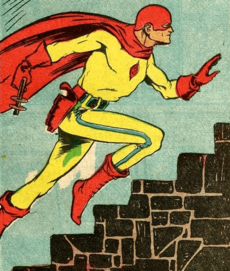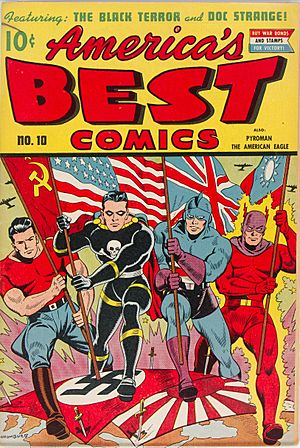Superhero facts for kids
A superhero is a fictional character who protects innocent people and fights for good. Superheroes often have special powers, like being super strong, super fast, or having amazing senses. They are usually brave and noble. Most superheroes also have a cool name and a colorful costume.
Some famous superheroes you might know include Superman, Batman, Aquaman, Spider-Man, Iron Man, Captain America, Hulk, Thor, and Wonder Woman.
Not all superheroes have superpowers. For example, Batman doesn't have any special powers, but he trained for many years to become super strong and smart. He uses his skills to fight bad guys.
Most superheroes keep their true identities a secret. They wear masks or helmets so villains don't know who they really are. This protects their friends and family from danger. Also, because superheroes sometimes act outside the usual rules, they keep their identities hidden to avoid trouble with the law.
Many superheroes have sad stories from their past that made them want to help others. For instance, Batman saw his parents get hurt when he was young. This made him decide to fight crime so it wouldn't happen to anyone else. Spider-Man learned a hard lesson when he didn't stop a thief, and that same thief later hurt his uncle. After that, Spider-Man realized he had to use his powers responsibly to help people.
Contents
The History of Superheroes
Superheroes have been around for a long time, changing and growing over the years.
Early Heroes (Before 1940)
The word 'superhero' first appeared in 1899. Before that, real-life "masked vigilantes" in the American Old West, like the San Diego Vigilantes, wore masks to fight outlaws. These real people might have inspired the idea of masked heroes.
In 1903, a British play called The Scarlet Pimpernel became popular. It showed a masked hero with a secret identity, which is a big part of superhero stories today. Over the next few decades, many masked characters appeared in pulp magazines and comic strips. Some examples are Zorro (1919), The Shadow (1930), and Flash Gordon (1934). Even characters without costumes but with super strength, like Popeye (1929), started to show up.
In Japan, an early superhero was Sarutobi Sasuke, a ninja from children's books in the 1910s. He had many superhuman powers.
The 1930s brought us some of the first costumed heroes with powers. Japan had Ōgon Bat (1931), who appeared in kamishibai (a type of picture storytelling). Then came Superman in 1938 and Captain Marvel in 1939. Superman's huge success led to many more heroes with secret identities and amazing powers. In 1939, Batman was created by Bob Kane and Bill Finger.
The Golden Age (1940s)
The 1940s were a busy time for superheroes! Many new heroes appeared, like The Flash, Green Lantern, and Blue Beetle.
One of the first female superheroes was Fantomah, who could turn into a skull-faced creature to fight evil. She appeared in 1940. Another early female hero was Invisible Scarlet O'Neil, who used invisibility to fight crime.
Captain America first appeared in December 1940, before the attack on Pearl Harbor. He was created by Joe Simon and Jack Kirby to represent the American spirit during World War II.
Some characters were more like "antiheroes," meaning they weren't always perfectly good. The Black Widow (not the Marvel one!) was an early example, fighting evildoers in her own way.
Many other female crime-fighters appeared, even if they didn't have superpowers. These included The Woman in Red (1940), Lady Luck (1940), Red Tornado (1940), Miss Fury (1941), Phantom Lady (1941), Black Cat (1941), and Black Canary (1947).
The most famous female superhero from this time is Wonder Woman. She was inspired by the myths of the Amazons and created by psychologist William Moulton Marston with help from his wife Elizabeth. Wonder Woman first appeared in 1941.
In Prague during World War II, an urban legend called Pérák became a symbol of hope, later seen as a Czech superhero.
The Silver Age (1950s)
In 1952, Osamu Tezuka's Japanese comic Tetsuwan Atom, known in the West as Astro Boy, was published. It was about a robot boy with amazing powers like flight and super strength.
The 1950s also brought the Silver Age of Comics. During this time, DC Comics introduced female versions of popular male heroes, like Batwoman (1956) and Supergirl.
In Japan, the first film series about the superhero Super Giant came out in 1957. This was a big moment for Japanese popular culture, shifting towards masked superheroes. Along with Astro Boy, the Super Giant films influenced Japanese television. In 1958, the superhero Moonlight Mask debuted on Japanese TV, starting a trend of live-action superhero shows called tokusatsu.
The Marvel Age (1960s)
The 1960s were a huge time for Marvel Comics. They introduced many popular superheroes who are still famous today. These include Spider-Man (1962), The Hulk, Iron Man, Daredevil, The Mighty Thor, and The Avengers (with heroes like Captain America, Thor, and Hulk). Many of these heroes got their own monthly comic books.
Superhero teams often had at least one female member. For example, the Justice League of America had Wonder Woman. The Fantastic Four had the Invisible Girl, and the X-Men had Jean Grey (originally Marvel Girl).
In 1963, Astro Boy became a very popular anime TV series. In 1966, the show Ultraman started a successful series where superheroes could grow as big as giant monsters to fight them.
Even the giant monster Godzilla, who started as a villain, began to be seen as a superhero in his movies from 1964 onwards. By the 1970s, many people thought of Godzilla as a superhero.
New Ideas (1970s)
The 1970s brought new kinds of superheroes to Japanese television. In 1971, Kamen Rider started a trend of "Henshin" (transformation) heroes. In 1972, the Science Ninja Team Gatchaman anime showed superhero teams with different colored costumes and special vehicles that could combine. Also, Mazinger Z created the "Super Robot" genre, featuring giant robots.
More anti-heroes appeared in the 1970s, like Skull Man (1970), Devilman (1972), and Punisher (1974). These characters often had darker stories.
The ideas of second-wave feminism, which focused on women's rights, influenced how female characters were shown in comics. Wonder Woman's story changed, and other female heroes like Supergirl got more important roles. New superheroines with strong feminist themes were introduced, such as Big Barda, Power Girl, and the Huntress from DC Comics, and the second Black Widow, Shanna the She-Devil, and The Cat from Marvel.
In 1975, Himitsu Sentai Gorenger started the Super Sentai franchise in Japan, which later became the American Power Rangers series in the 1990s. In 1978, a Japanese TV series of Spider-Man was made. In this show, Spider-Man had a vehicle that could turn into a giant robot, an idea that influenced later Japanese superhero shows.
Modern Heroes (1980s–Present)
In recent decades, many female characters like Dazzler, She-Hulk, Elektra, Catwoman, Witchblade, Spider-Girl, Batgirl, and the Birds of Prey have become stars of their own long-running comic series. Female characters also started taking on leadership roles in superhero teams, especially in the Uncanny X-Men comics. In 2013, the X-Men even had an all-female team.
With more Japanese anime, manga, and tokusatsu shows being translated, Western audiences began to see more Japanese superhero styles. Mighty Morphin Power Rangers, which used footage from the Japanese Zyuranger, became a huge hit. The Japanese comic book character Sailor Moon is also known worldwide as one of the most important and popular female superheroes ever created.
Images for kids
-
MLJ Comics' 1940s superhero the Black Hood
-
Publisher Standard Comics' America's Best Comics vol. 3, #1 (issue #7; Oct. 1943), showing superheroes battling leaders of the Axis powers during World War II. Cover art by Alex Schomburg.
-
MLJ Comics' 1940s superhero the Firefly
See also
 In Spanish: Superhéroe para niños
In Spanish: Superhéroe para niños








